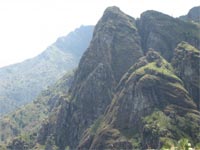A tour of Tanzania's Usambara Mountains, home of the African violet
 Lushoto, Tanzania - Many of East Africa's touristic highlights lie in Tanzania: Serengeti National Park, Mount Kilimanjaro and Zanzibar. Another area, the rain forests covering Tanzania's Usambara Mountains, may be little known to tourists but is a major attraction to scientists.
Lushoto, Tanzania - Many of East Africa's touristic highlights lie in Tanzania: Serengeti National Park, Mount Kilimanjaro and Zanzibar. Another area, the rain forests covering Tanzania's Usambara Mountains, may be little known to tourists but is a major attraction to scientists.
Most people's familiarity with the Usambaras is confined to the Usambara or African violet, which comes from this region near the coast of the Indian Ocean. Perhaps that is why Francis Mshami, a 73-year-old tour guide, stopped the minibus just outside the district centre of Lushoto and had his German tour group get out.
He pointed down the mountain to the town and declared, using the town's former name, "Welcome to Wilhelmstal! The territory of present-day Tanzania was part of the German colony of German East Africa from 1885 to 1919, and the Usambaras were a popular place of residence for German settlers because of their pleasant, low-mountain climate."
To escape the heat of the African savannah, the Church also moved into cool, malaria-free Wilhelmstal, making the area its base for missionary work. The numerous cloisters in the valleys are active to this day. Wilhelmstal rapidly developed into a district administrative centre of imperial Germany's colonial government.
On the way through Lushoto, Mshami kept pointing out old stone houses with red roofing tiles. The former colonial administration building, whose appearance is unmistakably German, is still the district's administrative headquarters. It is situated at the edge of town on the road leading to Jaegertal, where erstwhile farms of German settlers grace the green mountain landscape. Many are used as lodges today.
During a hike in the mountain forests, Mshami stopped nearly every three metres to acquaint the tourists with his homeland's diverse flora. The mountains seemed to be a gigantic open-air pharmacy. Mshami is a member of the Usambara-based Shambaa people, who have used the plants for centuries to cure diseases. He repeatedly snapped off leaves and twigs and explained their therapeutic effects.
The Eastern Arc Mountain Range, of which the Usambara rain forests are part, is ranked among the top 25 biodiversity regions in the world. More than 2,800 plant species are native to the Usambaras, a quarter of them growing there only. Moreover, 130 butterfly species, 25 reptile species and a dozen species of small mammals exist there and nowhere else. For this reason scientists call the region the "African Galapagos in the clouds."
The Usambaras were unknown to Europeans until relatively recently. In 1498, Portuguese navigator Vasco da Gama became the first European to see them from the coast. The first Europeans to cross them, in 1848, were German adventurers and Protestant missionaries Johannes Rebmann and Johann Ludwig Krapf.
Not much remains of the immense virgin forests that Rebmann and Krapf saw. Large swaths have been cleared in recent decades, mainly due to the increase in the region's population.
Nevertheless, extensive forest reserves in the West Usambaras beckon hikers, including Shagayu, Bumbuli Baga and Magamba Mkuzu. Especially beautiful trekking trails lead to Irente Viewpoint, which offers a broad outlook onto the arid savannah. The only place having a more spectacular view is World Viewpoint, on a cliff with a sheer drop of more than 1,500 metres.
Worth seeing in the East Usambaras is the dense Magoroto Forest in the Amani Nature Reserve.
Internet: http://tanzaniatouristboard.com (dpa)